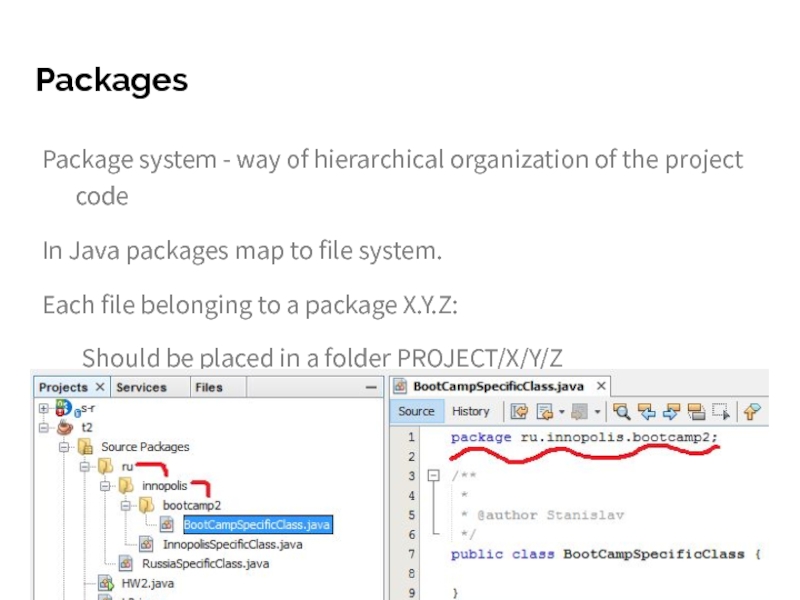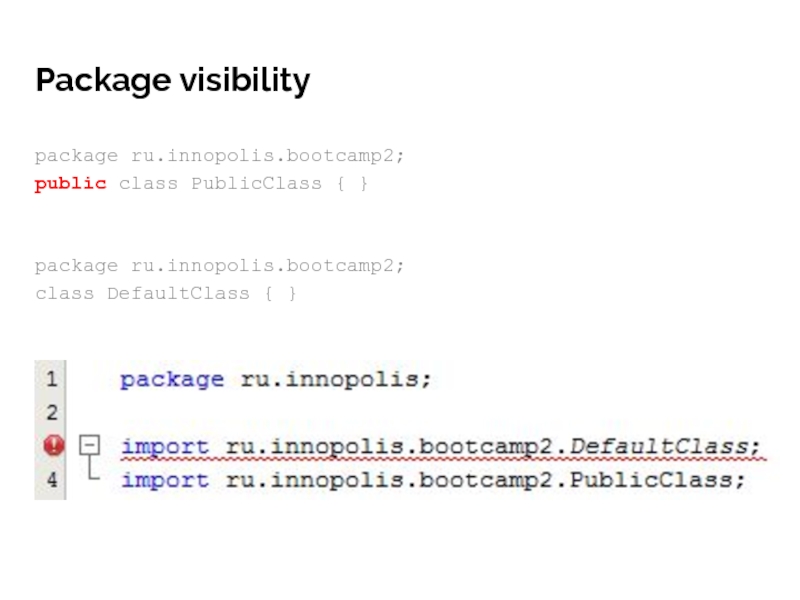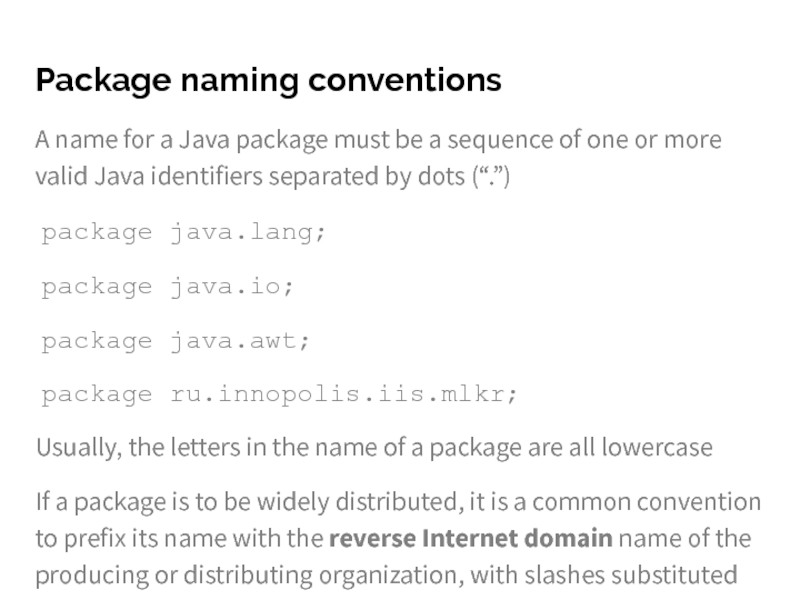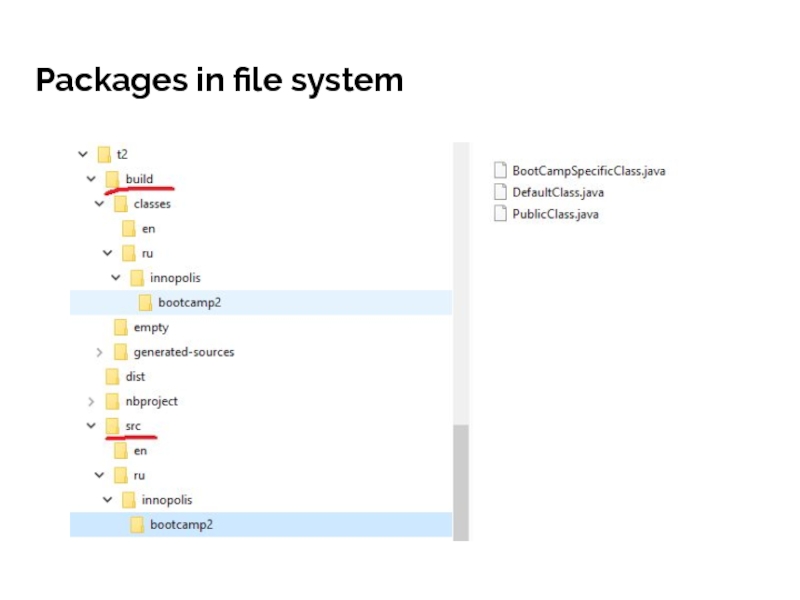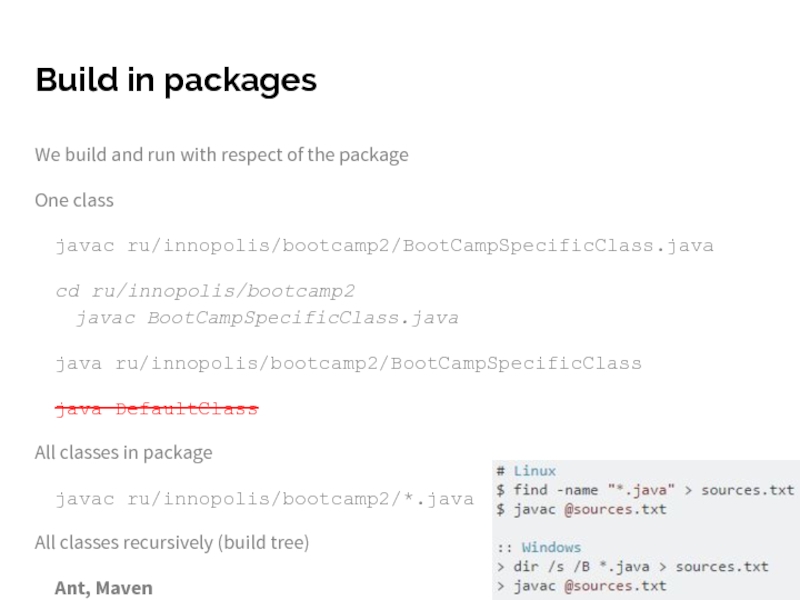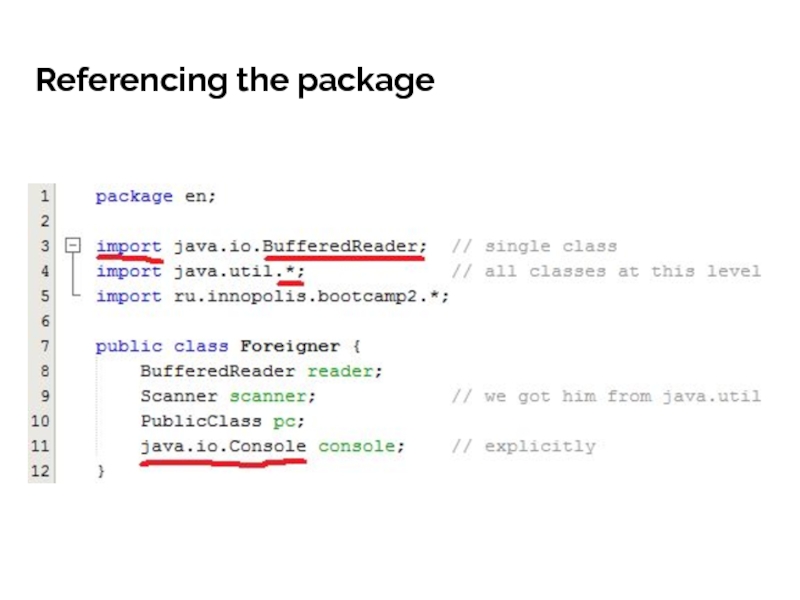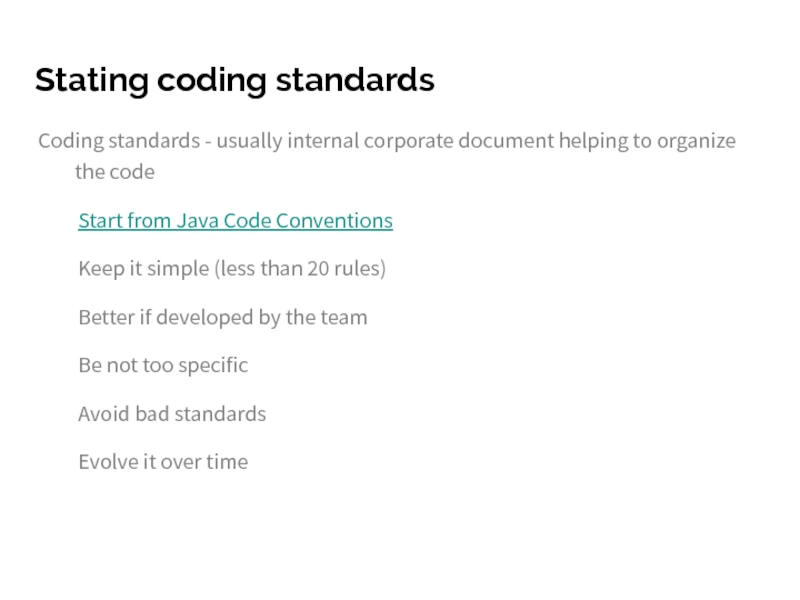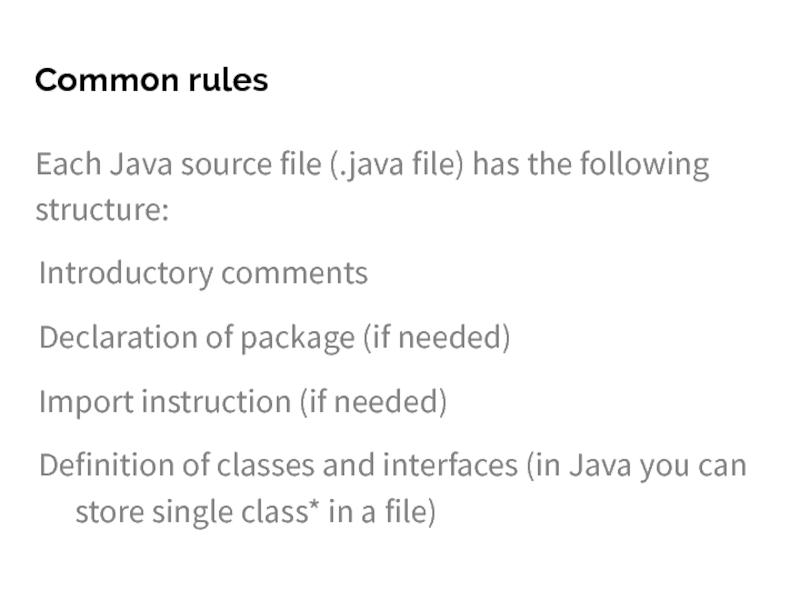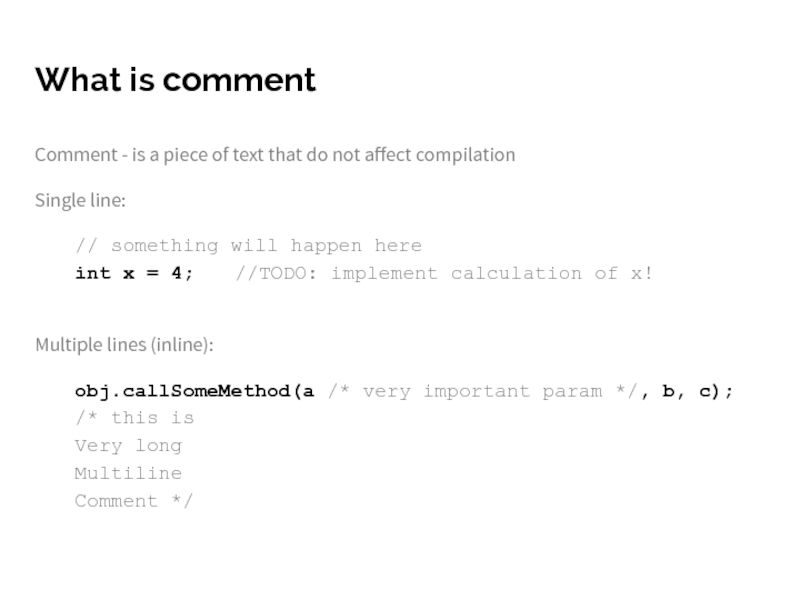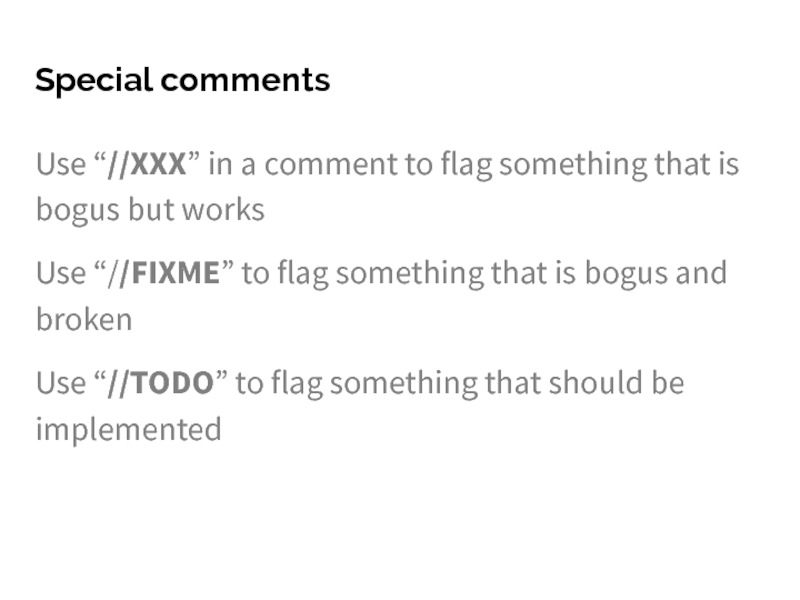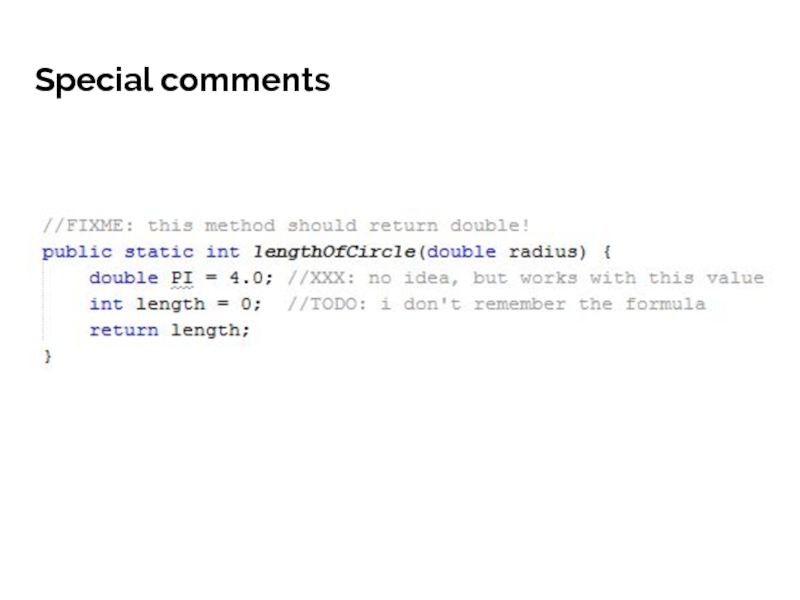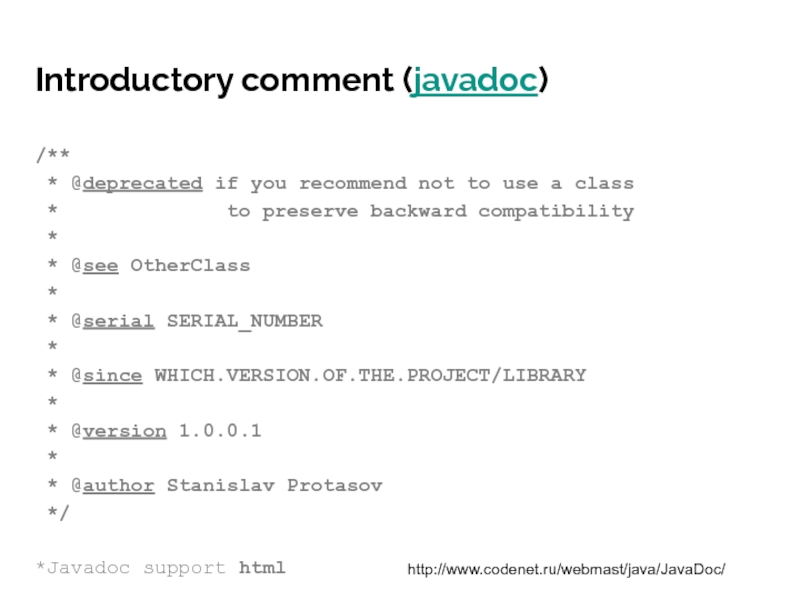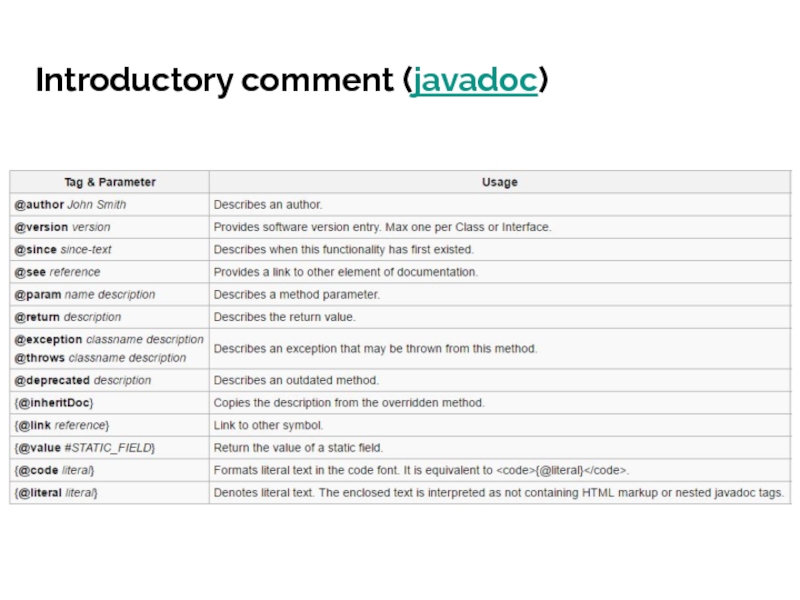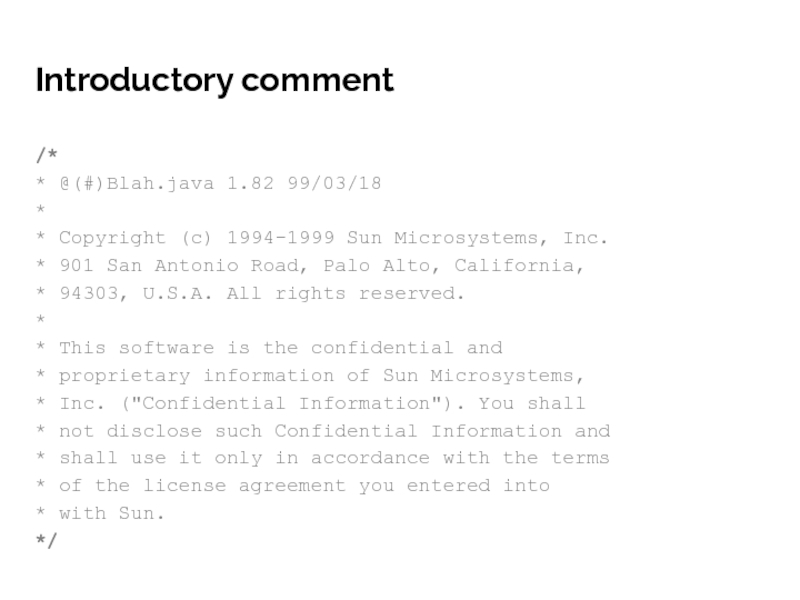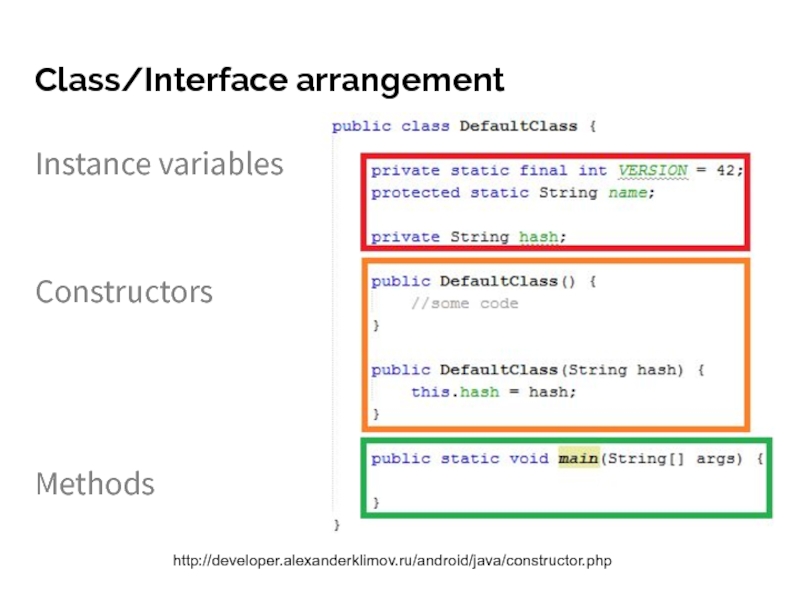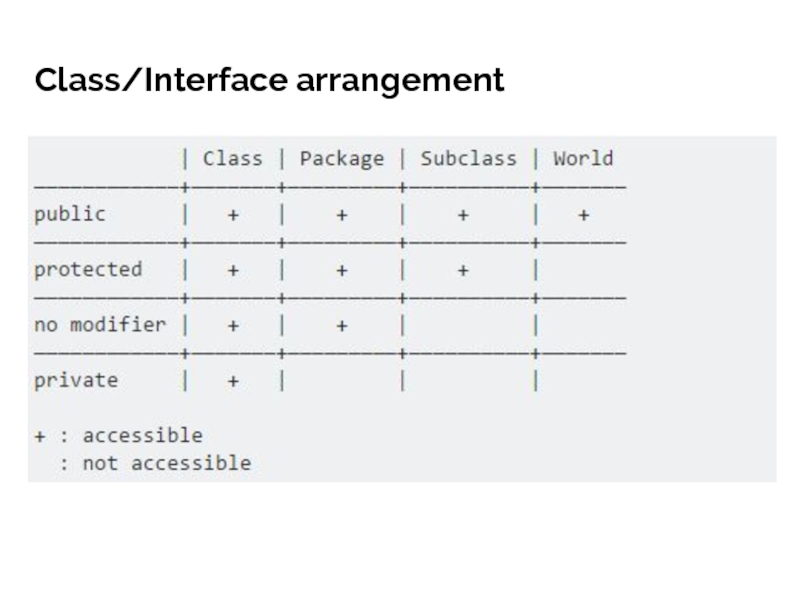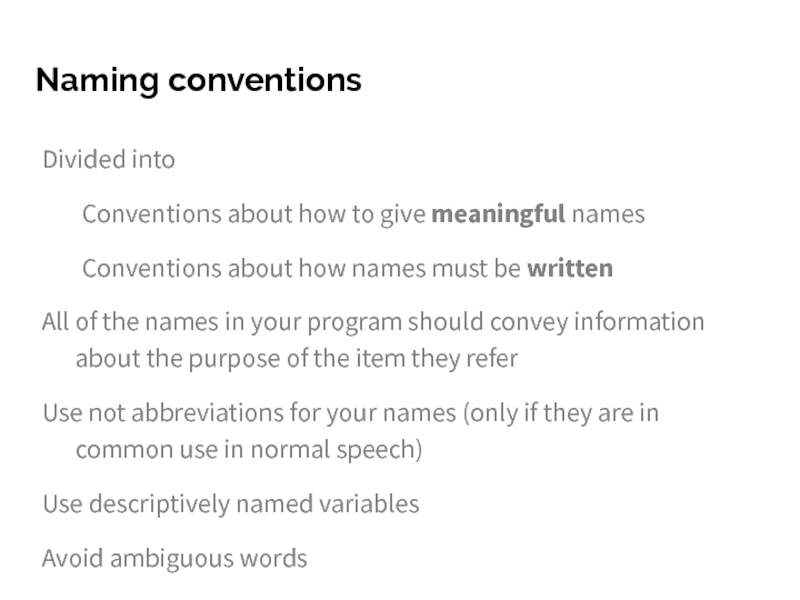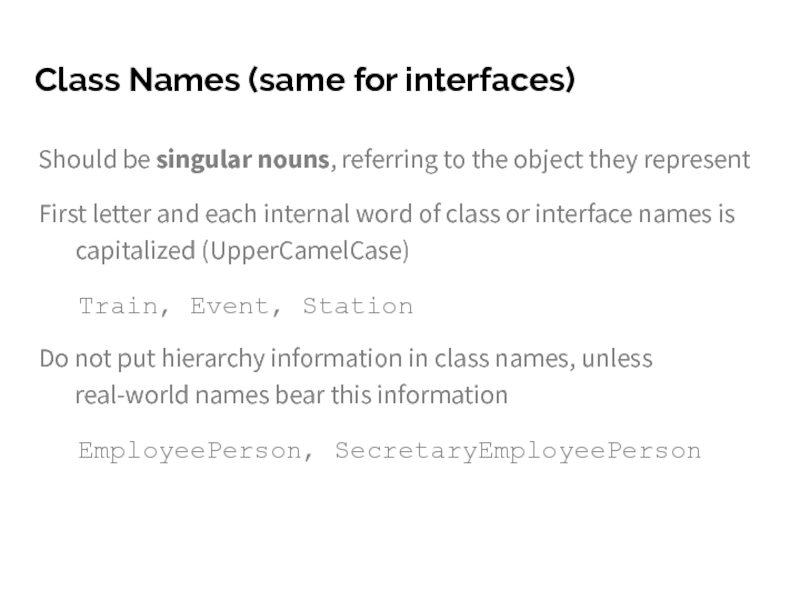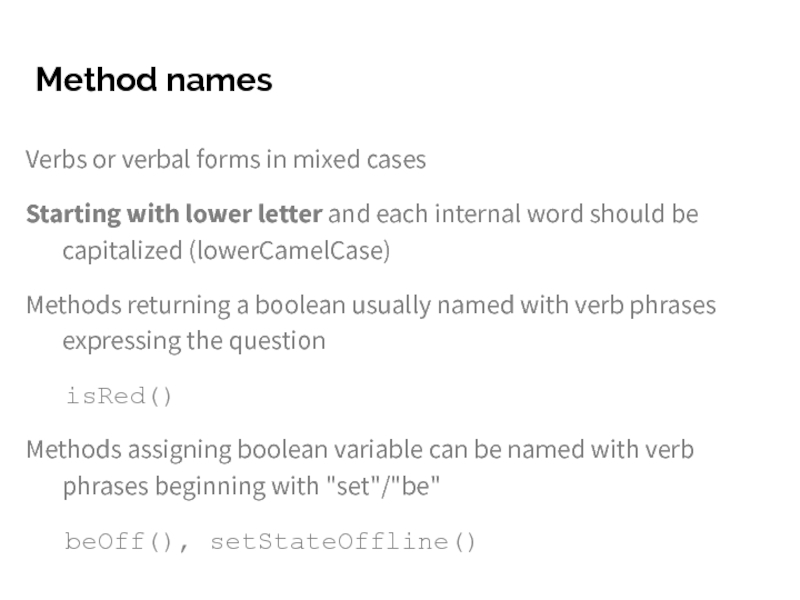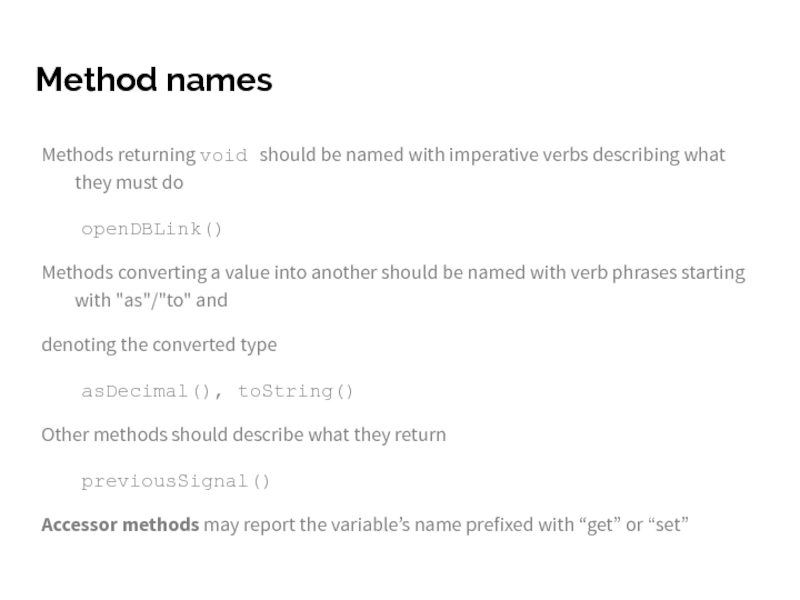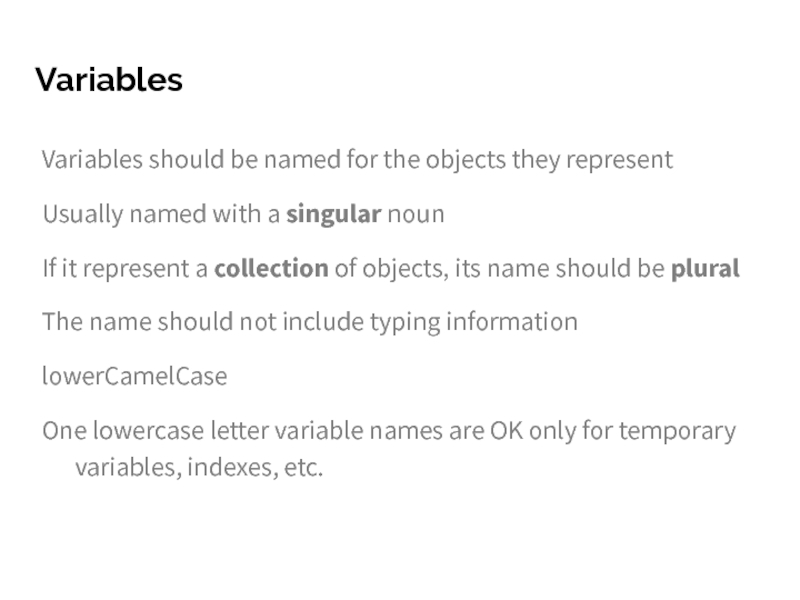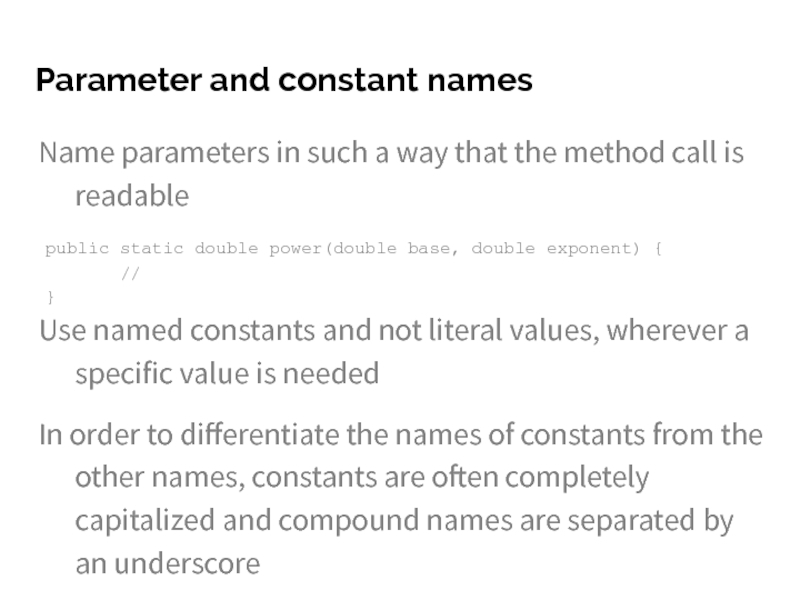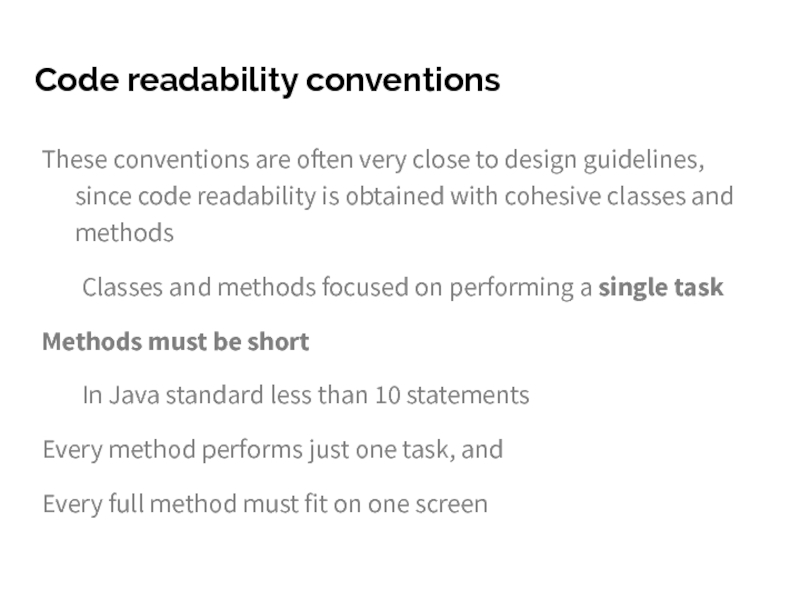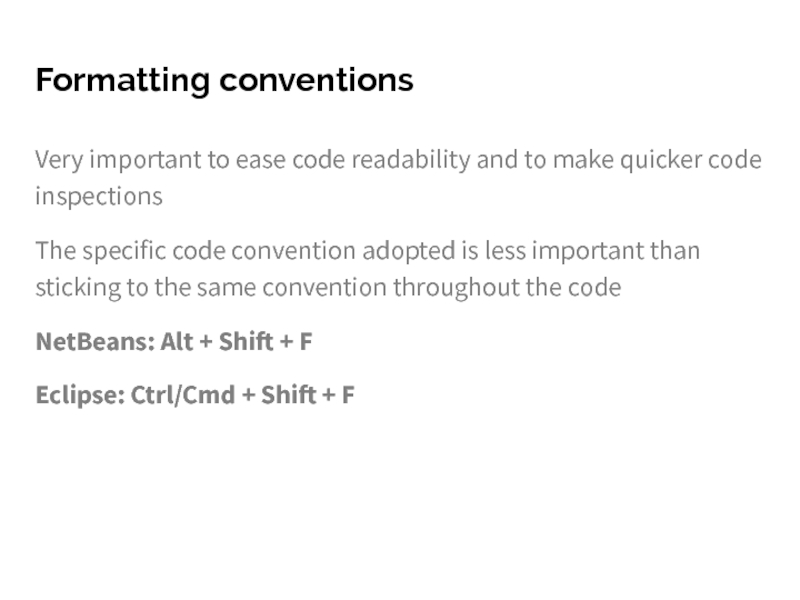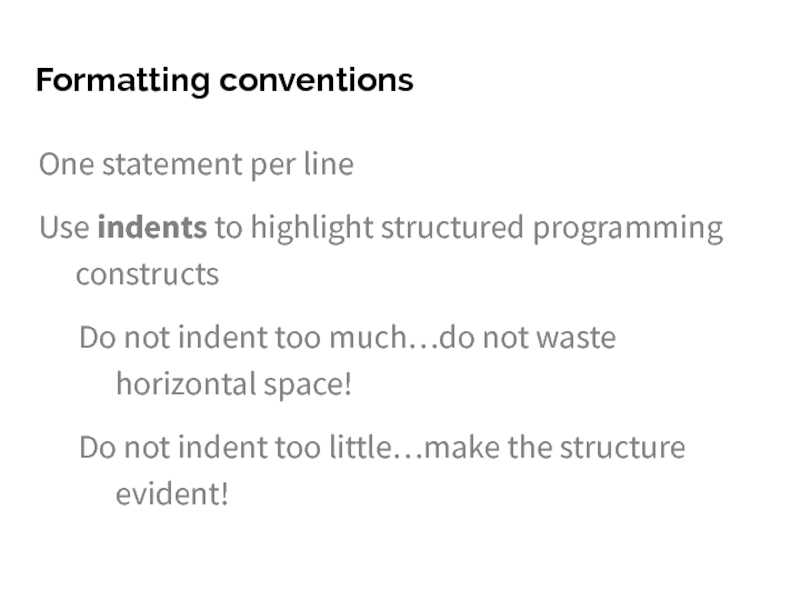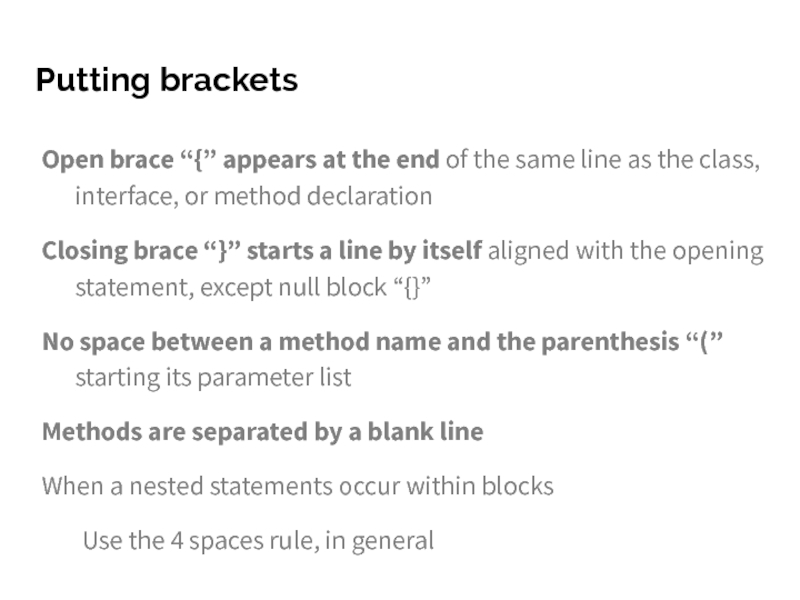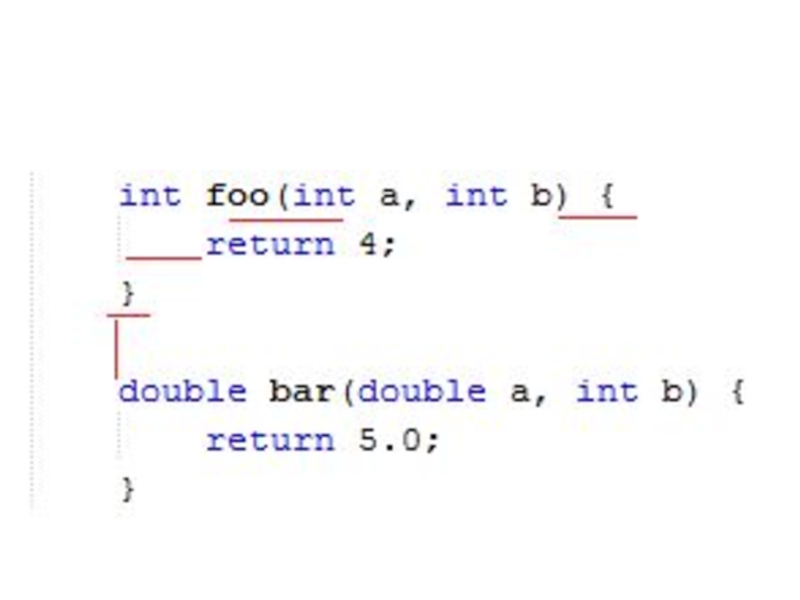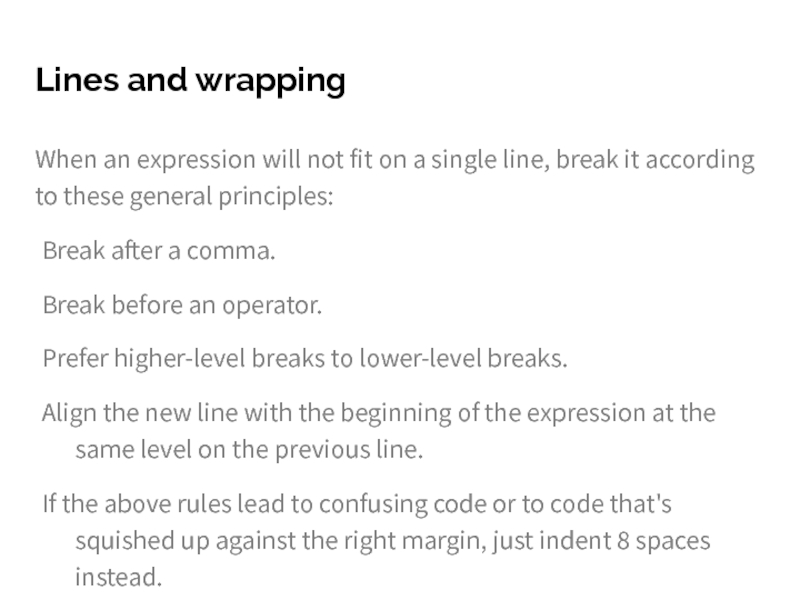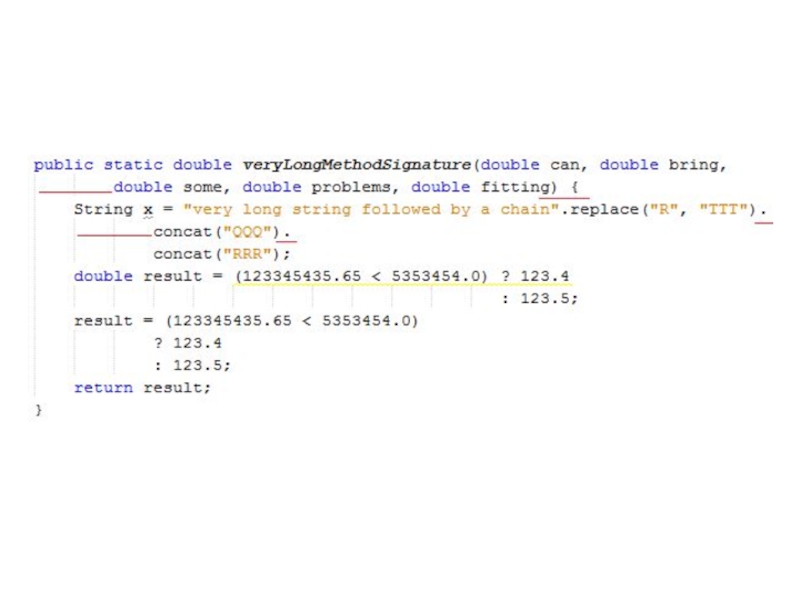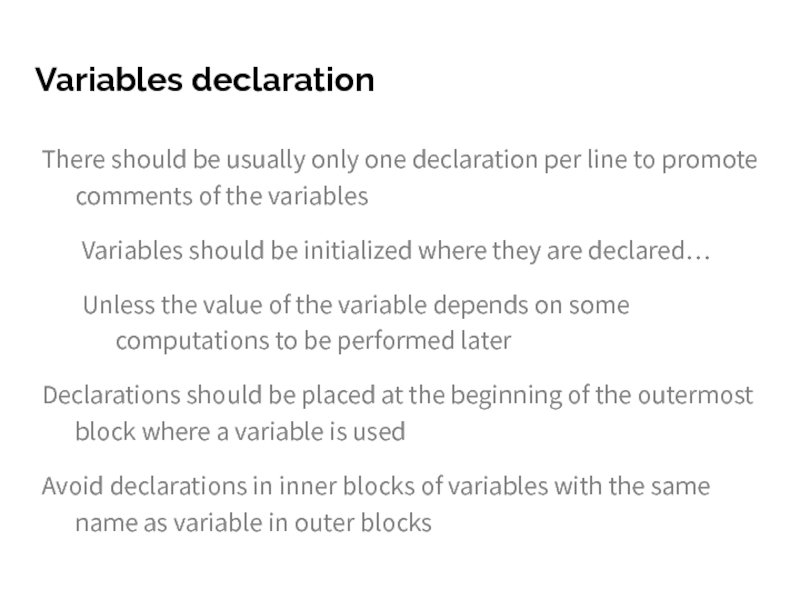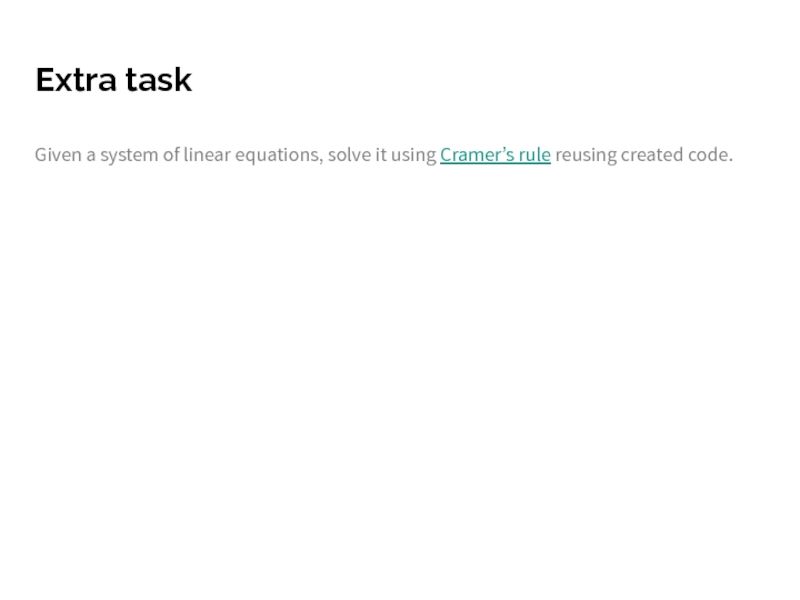- Главная
- Разное
- Дизайн
- Бизнес и предпринимательство
- Аналитика
- Образование
- Развлечения
- Красота и здоровье
- Финансы
- Государство
- Путешествия
- Спорт
- Недвижимость
- Армия
- Графика
- Культурология
- Еда и кулинария
- Лингвистика
- Английский язык
- Астрономия
- Алгебра
- Биология
- География
- Детские презентации
- Информатика
- История
- Литература
- Маркетинг
- Математика
- Медицина
- Менеджмент
- Музыка
- МХК
- Немецкий язык
- ОБЖ
- Обществознание
- Окружающий мир
- Педагогика
- Русский язык
- Технология
- Физика
- Философия
- Химия
- Шаблоны, картинки для презентаций
- Экология
- Экономика
- Юриспруденция
Few words about how to write [disputably] nice code презентация
Содержание
- 1. Few words about how to write [disputably] nice code
- 2. Packages Package system - way of hierarchical
- 3. Package visibility package ru.innopolis.bootcamp2; public class PublicClass
- 4. Package naming conventions A name for a
- 5. Packages in file system
- 6. Build in packages We build and run
- 7. Referencing the package
- 8. Stating coding standards Coding standards - usually
- 9. Stating coding standards
- 10. Common rules Each Java source file (.java
- 11. What is comment Comment - is a
- 12. Special comments Use “//XXX” in a comment
- 13. Special comments
- 14. Introductory comment (javadoc) /** * @deprecated
- 15. Introductory comment (javadoc)
- 16. Introductory comment /* * @(#)Blah.java 1.82 99/03/18
- 17. Class/Interface arrangement Instance variables Constructors Methods http://developer.alexanderklimov.ru/android/java/constructor.php
- 18. Class/Interface arrangement
- 19. Naming conventions Divided into Conventions about how
- 20. Class Names (same for interfaces) Should be
- 21. Method names Verbs or verbal forms in
- 22. Method names Methods returning void should be
- 23. Variables Variables should be named for the
- 25. Parameter and constant names Name parameters in
- 27. Code readability conventions These conventions are often
- 28. Formatting conventions Very important to ease code
- 29. Formatting conventions One statement per line Use
- 30. Putting brackets Open brace “{” appears at
- 32. Lines and wrapping When an expression will
- 34. Variables declaration There should be usually only
- 35. Example of good style http://www.docjar.net/html/api/java/util/Collections.java.html
- 36. Extra task Given a system of linear
Слайд 2Packages
Package system - way of hierarchical organization of the project code
In
Java packages map to file system.
Each file belonging to a package X.Y.Z:
Should be placed in a folder PROJECT/X/Y/Z
Should have explicit declaration package X.Y.Z;
Each file belonging to a package X.Y.Z:
Should be placed in a folder PROJECT/X/Y/Z
Should have explicit declaration package X.Y.Z;
Слайд 3Package visibility
package ru.innopolis.bootcamp2;
public class PublicClass { }
package ru.innopolis.bootcamp2;
class DefaultClass { }
Слайд 4Package naming conventions
A name for a Java package must be a
sequence of one or more valid Java identifiers separated by dots (“.”)
package java.lang;
package java.io;
package java.awt;
package ru.innopolis.iis.mlkr;
Usually, the letters in the name of a package are all lowercase
If a package is to be widely distributed, it is a common convention to prefix its name with the reverse Internet domain name of the producing or distributing organization, with slashes substituted by dots.
package java.lang;
package java.io;
package java.awt;
package ru.innopolis.iis.mlkr;
Usually, the letters in the name of a package are all lowercase
If a package is to be widely distributed, it is a common convention to prefix its name with the reverse Internet domain name of the producing or distributing organization, with slashes substituted by dots.
Слайд 6Build in packages
We build and run with respect of the package
One
class
javac ru/innopolis/bootcamp2/BootCampSpecificClass.java
cd ru/innopolis/bootcamp2 javac BootCampSpecificClass.java
java ru/innopolis/bootcamp2/BootCampSpecificClass
java DefaultClass
All classes in package
javac ru/innopolis/bootcamp2/*.java
All classes recursively (build tree)
Ant, Maven
javac ru/innopolis/bootcamp2/BootCampSpecificClass.java
cd ru/innopolis/bootcamp2 javac BootCampSpecificClass.java
java ru/innopolis/bootcamp2/BootCampSpecificClass
java DefaultClass
All classes in package
javac ru/innopolis/bootcamp2/*.java
All classes recursively (build tree)
Ant, Maven
Слайд 8Stating coding standards
Coding standards - usually internal corporate document helping to
organize the code
Start from Java Code Conventions
Keep it simple (less than 20 rules)
Better if developed by the team
Be not too specific
Avoid bad standards
Evolve it over time
Start from Java Code Conventions
Keep it simple (less than 20 rules)
Better if developed by the team
Be not too specific
Avoid bad standards
Evolve it over time
Слайд 10Common rules
Each Java source file (.java file) has the following structure:
Introductory
comments
Declaration of package (if needed)
Import instruction (if needed)
Definition of classes and interfaces (in Java you can store single class* in a file)
Declaration of package (if needed)
Import instruction (if needed)
Definition of classes and interfaces (in Java you can store single class* in a file)
Слайд 11What is comment
Comment - is a piece of text that do
not affect compilation
Single line:
// something will happen here
int x = 4; //TODO: implement calculation of x!
Multiple lines (inline):
obj.callSomeMethod(a /* very important param */, b, c);
/* this is
Very long
Multiline
Comment */
Single line:
// something will happen here
int x = 4; //TODO: implement calculation of x!
Multiple lines (inline):
obj.callSomeMethod(a /* very important param */, b, c);
/* this is
Very long
Multiline
Comment */
Слайд 12Special comments
Use “//XXX” in a comment to flag something that is
bogus but works
Use “//FIXME” to flag something that is bogus and broken
Use “//TODO” to flag something that should be implemented
Use “//FIXME” to flag something that is bogus and broken
Use “//TODO” to flag something that should be implemented
Слайд 14Introductory comment (javadoc)
/**
* @deprecated if you recommend not to use
a class
* to preserve backward compatibility
*
* @see OtherClass
*
* @serial SERIAL_NUMBER
*
* @since WHICH.VERSION.OF.THE.PROJECT/LIBRARY
*
* @version 1.0.0.1
*
* @author Stanislav Protasov
*/
*Javadoc support html
* to preserve backward compatibility
*
* @see OtherClass
*
* @serial SERIAL_NUMBER
*
* @since WHICH.VERSION.OF.THE.PROJECT/LIBRARY
*
* @version 1.0.0.1
*
* @author Stanislav Protasov
*/
*Javadoc support html
http://www.codenet.ru/webmast/java/JavaDoc/
Слайд 16Introductory comment
/*
* @(#)Blah.java 1.82 99/03/18
*
* Copyright (c) 1994-1999 Sun Microsystems, Inc.
*
901 San Antonio Road, Palo Alto, California,
* 94303, U.S.A. All rights reserved.
*
* This software is the confidential and
* proprietary information of Sun Microsystems,
* Inc. ("Confidential Information"). You shall
* not disclose such Confidential Information and
* shall use it only in accordance with the terms
* of the license agreement you entered into
* with Sun.
*/
* 94303, U.S.A. All rights reserved.
*
* This software is the confidential and
* proprietary information of Sun Microsystems,
* Inc. ("Confidential Information"). You shall
* not disclose such Confidential Information and
* shall use it only in accordance with the terms
* of the license agreement you entered into
* with Sun.
*/
Слайд 17Class/Interface arrangement
Instance variables
Constructors
Methods
http://developer.alexanderklimov.ru/android/java/constructor.php
Слайд 19Naming conventions
Divided into
Conventions about how to give meaningful names
Conventions about how
names must be written
All of the names in your program should convey information about the purpose of the item they refer
Use not abbreviations for your names (only if they are in common use in normal speech)
Use descriptively named variables
Avoid ambiguous words
All of the names in your program should convey information about the purpose of the item they refer
Use not abbreviations for your names (only if they are in common use in normal speech)
Use descriptively named variables
Avoid ambiguous words
Слайд 20Class Names (same for interfaces)
Should be singular nouns, referring to the
object they represent
First letter and each internal word of class or interface names is capitalized (UpperCamelCase)
Train, Event, Station
Do not put hierarchy information in class names, unless real-world names bear this information
EmployeePerson, SecretaryEmployeePerson
First letter and each internal word of class or interface names is capitalized (UpperCamelCase)
Train, Event, Station
Do not put hierarchy information in class names, unless real-world names bear this information
EmployeePerson, SecretaryEmployeePerson
Слайд 21Method names
Verbs or verbal forms in mixed cases
Starting with lower letter
and each internal word should be capitalized (lowerCamelCase)
Methods returning a boolean usually named with verb phrases expressing the question
isRed()
Methods assigning boolean variable can be named with verb phrases beginning with "set"/"be"
beOff(), setStateOffline()
Methods returning a boolean usually named with verb phrases expressing the question
isRed()
Methods assigning boolean variable can be named with verb phrases beginning with "set"/"be"
beOff(), setStateOffline()
Слайд 22Method names
Methods returning void should be named with imperative verbs describing
what they must do
openDBLink()
Methods converting a value into another should be named with verb phrases starting with "as"/"to" and
denoting the converted type
asDecimal(), toString()
Other methods should describe what they return
previousSignal()
Accessor methods may report the variable’s name prefixed with “get” or “set”
openDBLink()
Methods converting a value into another should be named with verb phrases starting with "as"/"to" and
denoting the converted type
asDecimal(), toString()
Other methods should describe what they return
previousSignal()
Accessor methods may report the variable’s name prefixed with “get” or “set”
Слайд 23Variables
Variables should be named for the objects they represent
Usually named with
a singular noun
If it represent a collection of objects, its name should be plural
The name should not include typing information
lowerCamelCase
One lowercase letter variable names are OK only for temporary variables, indexes, etc.
If it represent a collection of objects, its name should be plural
The name should not include typing information
lowerCamelCase
One lowercase letter variable names are OK only for temporary variables, indexes, etc.
Слайд 25Parameter and constant names
Name parameters in such a way that the
method call is readable
public static double power(double base, double exponent) {
//
}
Use named constants and not literal values, wherever a specific value is needed
In order to differentiate the names of constants from the other names, constants are often completely capitalized and compound names are separated by an underscore
public static double power(double base, double exponent) {
//
}
Use named constants and not literal values, wherever a specific value is needed
In order to differentiate the names of constants from the other names, constants are often completely capitalized and compound names are separated by an underscore
Слайд 27Code readability conventions
These conventions are often very close to design guidelines,
since code readability is obtained with cohesive classes and methods
Classes and methods focused on performing a single task
Methods must be short
In Java standard less than 10 statements
Every method performs just one task, and
Every full method must fit on one screen
Classes and methods focused on performing a single task
Methods must be short
In Java standard less than 10 statements
Every method performs just one task, and
Every full method must fit on one screen
Слайд 28Formatting conventions
Very important to ease code readability and to make quicker
code inspections
The specific code convention adopted is less important than sticking to the same convention throughout the code
NetBeans: Alt + Shift + F
Eclipse: Ctrl/Cmd + Shift + F
The specific code convention adopted is less important than sticking to the same convention throughout the code
NetBeans: Alt + Shift + F
Eclipse: Ctrl/Cmd + Shift + F
Слайд 29Formatting conventions
One statement per line
Use indents to highlight structured programming constructs
Do
not indent too much…do not waste horizontal space!
Do not indent too little…make the structure evident!
Do not indent too little…make the structure evident!
Слайд 30Putting brackets
Open brace “{” appears at the end of the same
line as the class, interface, or method declaration
Closing brace “}” starts a line by itself aligned with the opening statement, except null block “{}”
No space between a method name and the parenthesis “(” starting its parameter list
Methods are separated by a blank line
When a nested statements occur within blocks
Use the 4 spaces rule, in general
Closing brace “}” starts a line by itself aligned with the opening statement, except null block “{}”
No space between a method name and the parenthesis “(” starting its parameter list
Methods are separated by a blank line
When a nested statements occur within blocks
Use the 4 spaces rule, in general
Слайд 32Lines and wrapping
When an expression will not fit on a single
line, break it according to these general principles:
Break after a comma.
Break before an operator.
Prefer higher-level breaks to lower-level breaks.
Align the new line with the beginning of the expression at the same level on the previous line.
If the above rules lead to confusing code or to code that's squished up against the right margin, just indent 8 spaces instead.
Break after a comma.
Break before an operator.
Prefer higher-level breaks to lower-level breaks.
Align the new line with the beginning of the expression at the same level on the previous line.
If the above rules lead to confusing code or to code that's squished up against the right margin, just indent 8 spaces instead.
Слайд 34Variables declaration
There should be usually only one declaration per line to
promote comments of the variables
Variables should be initialized where they are declared…
Unless the value of the variable depends on some computations to be performed later
Declarations should be placed at the beginning of the outermost block where a variable is used
Avoid declarations in inner blocks of variables with the same name as variable in outer blocks
Variables should be initialized where they are declared…
Unless the value of the variable depends on some computations to be performed later
Declarations should be placed at the beginning of the outermost block where a variable is used
Avoid declarations in inner blocks of variables with the same name as variable in outer blocks
Слайд 36Extra task
Given a system of linear equations, solve it using Cramer’s
rule reusing created code.
![Few words about how to write [disputably] nice codeKamill Gusmanov](/img/tmb/5/442265/a46dd9517ea3eff3cc65d09099d37ede-800x.jpg)
